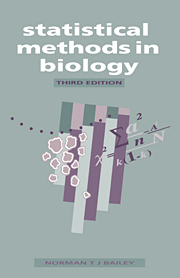Book contents
- Frontmatter
- Contents
- Preface
- 1 Introduction
- 2 Variability and frequency distributions
- 3 Estimation, standard errors and confidence limits
- 4 The basic idea of a significance test
- 5 Simple significance tests based on the normal distribution
- 6 The use of t-tests for small samples
- 7 Contingency tables and χ2
- 8 χ2-tests of goodness-of-fit and homogeneity
- 9 The correlation of measurements
- 10 Regression analysis
- 11 Simple experimental design and the analysis of variance
- 12 Introduction to factorial experiments
- 13 Random samples and random numbers
- 14 Partial correlation and multiple regression
- 15 Non-parametric and distribution-free tests
- 16 Notes on numerical calculation, calculators and computers
- Suggestions for more advanced reading
- Summary of statistical formulae
- Appendix tables
- Index
14 - Partial correlation and multiple regression
Published online by Cambridge University Press: 05 June 2012
- Frontmatter
- Contents
- Preface
- 1 Introduction
- 2 Variability and frequency distributions
- 3 Estimation, standard errors and confidence limits
- 4 The basic idea of a significance test
- 5 Simple significance tests based on the normal distribution
- 6 The use of t-tests for small samples
- 7 Contingency tables and χ2
- 8 χ2-tests of goodness-of-fit and homogeneity
- 9 The correlation of measurements
- 10 Regression analysis
- 11 Simple experimental design and the analysis of variance
- 12 Introduction to factorial experiments
- 13 Random samples and random numbers
- 14 Partial correlation and multiple regression
- 15 Non-parametric and distribution-free tests
- 16 Notes on numerical calculation, calculators and computers
- Suggestions for more advanced reading
- Summary of statistical formulae
- Appendix tables
- Index
Summary
INTRODUCTION
In Chapters 9 and 10 we saw how the techniques of correlation and regression could be used to study the association between two quantitative variables. Which method was most appropriate depended to a great extent on the sort of mathematical picture that best described the data. As we saw, correlation techniques were suitable when we had two measurements that approximately followed a bivariate normal distribution. If, on the other hand, one measurement, x, was arbitrarily or irregularly distributed, and we were chiefly interested in the behaviour of a second measurement, y, in relation to the first, then regression might be more appropriate. The basic assumptions made in that case were that the true means µx, when plotted against the corresponding values of x, lay on a straight line, and that variation about this line followed a normal distribution whose variance was independent of x.
These methods are extremely powerful when we have only a single pair of variables to investigate. Quite often, however, measurements of different kinds will occur in batches. Although we could use the simple correlation or regression analyses, taking the variables two at a time, this would not only be unwieldy but would fail to reveal more complicated patterns of relationship that might exist between several variables simultaneously. We therefore require extensions of the previous methods specially adapted to handling groups of variables, and the appropriate techniques are those of partial correlation and multiple regression.
Information
- Type
- Chapter
- Information
- Statistical Methods in Biology , pp. 156 - 171Publisher: Cambridge University PressPrint publication year: 1995
